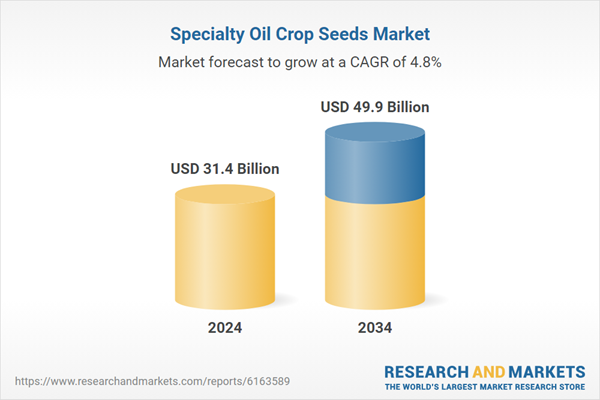Besides human consumption, specialty oils are widely used in personal care and cosmetic products for their moisturizing and anti-aging properties. The pharmaceutical and nutraceutical sectors value these oils for their therapeutic effects. Furthermore, the shift toward chemical-free and natural products has increased their application in industrial uses and animal nutrition as well.
In 2024, the canola/rapeseed specialty varieties segment held a 30.1% share and is expected to grow at a CAGR of 4.9% through 2034. Their high oil content, nutritional value, and adaptability make them a leading segment in this market. Canola oil, known for its low saturated fat and high omega-3 fatty acid content, is favored by health-conscious consumers and food producers. Its ability to grow under diverse climatic conditions and a short cultivation cycle makes it attractive to farmers.
The seed oils segment represented a significant 34.8% share in 2024. This segment benefits from the rising consumer focus on health-promoting, organic, and non-GMO products. The growing interest in clean-label foods, combined with the surge in vegetarian and vegan diets, is fueling innovation and demand within the seed oil market.
United States Specialty Oil Crop Seeds Market generated USD 8.8 billion in revenue in 2024 and is projected to grow at a CAGR of 3.7% through 2034. The U.S. leads due to its advanced agricultural infrastructure, ample farmland, and technological advancements. American farmers prioritize top-quality seed varieties for commercial cultivation, including sunflowers, canola, and soybeans. Additionally, emerging startups in the agricultural sector are introducing innovations that meet the evolving preferences of consumers nationwide.
Key players in the Global Specialty Oil Crop Seeds Market include Limagrain, ZeaKal Inc., Corteva Agriscience, Bayer Crop Science (Monsanto), AgReliant Genetics, BASF SE, Nuseed (Nufarm), Syngenta AG, Smart Earth Seeds, Sakata Seed Corporation, and KWS SAAT SE. Companies in the specialty oil crop seeds market are focusing on several strategic initiatives to bolster their market position. Innovation in seed genetics and biotechnology is paramount, allowing firms to develop higher-yielding, disease-resistant, and climate-resilient crop varieties. Collaborations and partnerships with agricultural research institutions enhance R&D capabilities, helping companies stay ahead in a competitive landscape. Expanding global distribution networks enables wider market reach, particularly in emerging regions with growing demand. Many players are also emphasizing sustainable and organic seed options to align with consumer preferences for eco-friendly products.
This product will be delivered within 2-4 business days.
Table of Contents
Companies Mentioned
The companies profiled in this Specialty Oil Crop Seeds market report include:- AgReliant Genetics
- BASF SE
- Bayer Crop Science (Monsanto)
- Corteva Agriscience
- KWS SAAT SE
- Limagrain
- Nuseed (Nufarm)
- Sakata Seed Corporation
- Smart Earth Seeds
- Syngenta AG
- ZeaKal Inc.
Table Information
| Report Attribute | Details |
|---|---|
| No. of Pages | 192 |
| Published | July 2025 |
| Forecast Period | 2024 - 2034 |
| Estimated Market Value ( USD | $ 31.4 Billion |
| Forecasted Market Value ( USD | $ 49.9 Billion |
| Compound Annual Growth Rate | 4.8% |
| Regions Covered | Global |
| No. of Companies Mentioned | 12 |









